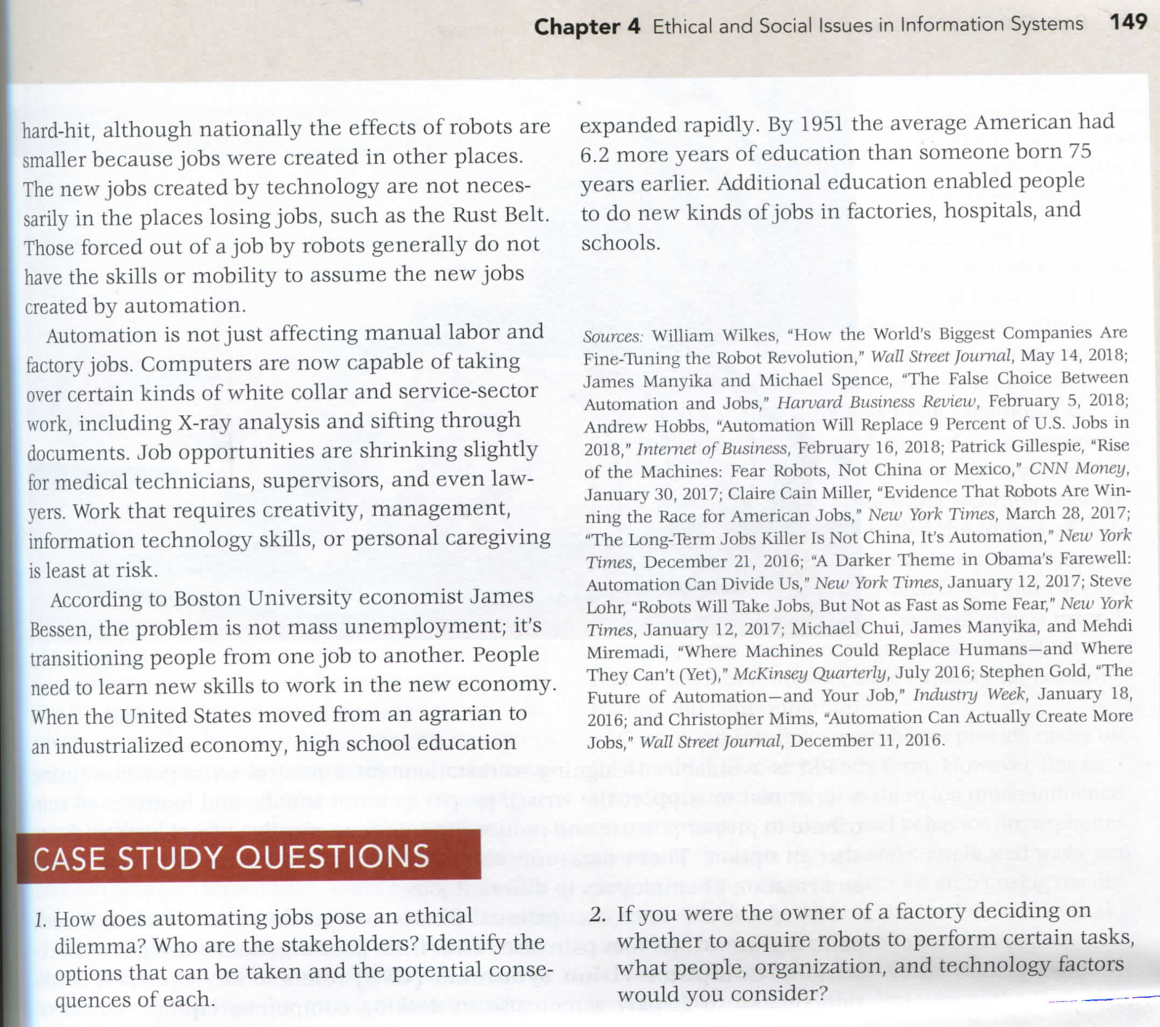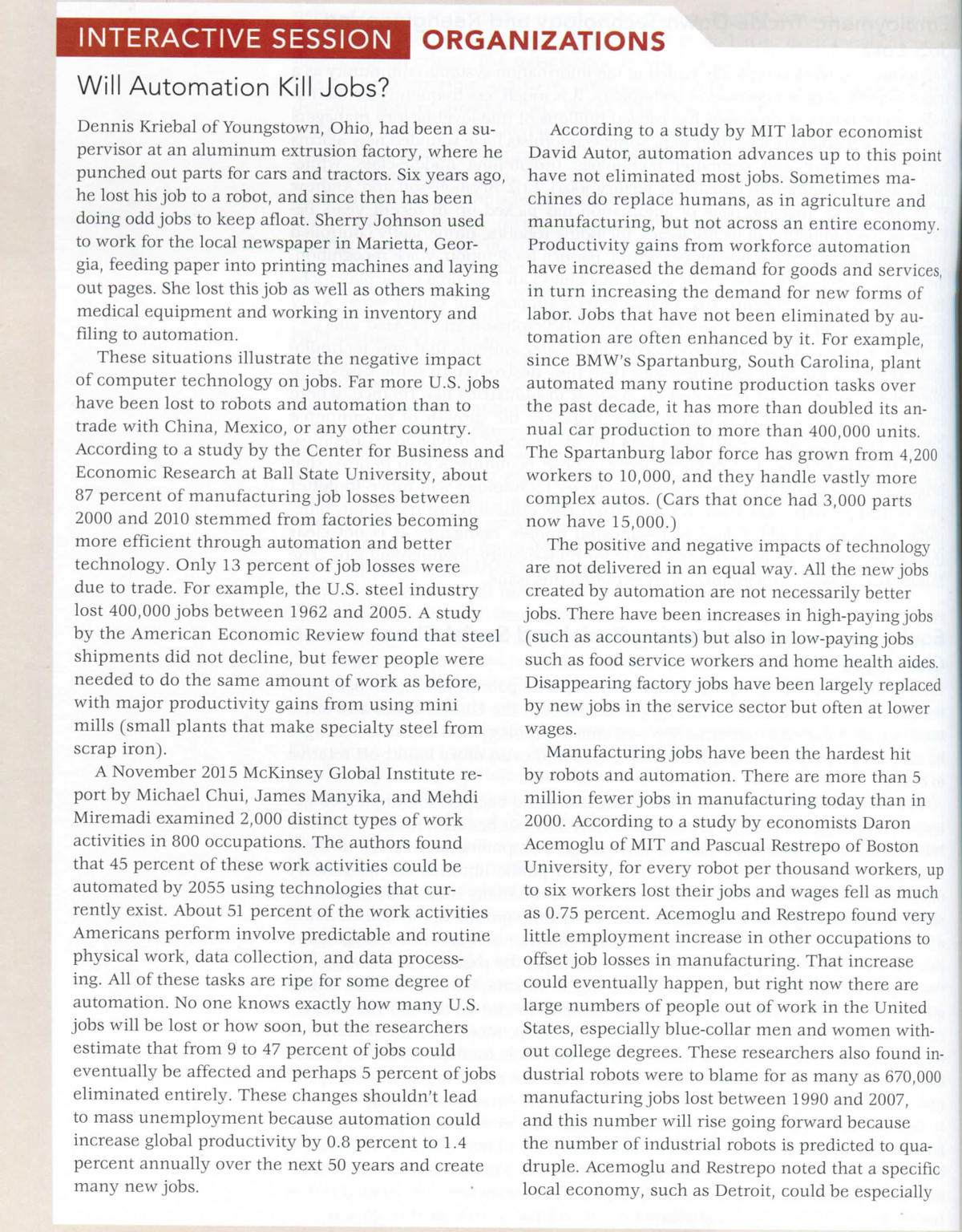How does automating jobs pose an ethical dilemma? Who are the stakeholders? Identify the options that can be taken and the potential consequences of each. If you were the owner of a factory deciding on whether to acquire robots to perform certain tsks, what people, organization, and technology factors would you consider?
How does automating jobs pose an ethical dilemma? Who are the stakeholders? Identify the options that can be taken and the potential consequences of each. If you were the owner of a factory deciding on whether to acquire robots to perform certain tsks, what people, organization, and technology factors would you consider?
Chapter10: Application Development
Section: Chapter Questions
Problem 3RP
Related questions
Question
- How does automating jobs pose an ethical dilemma? Who are the stakeholders? Identify the options that can be taken and the potential consequences of each.
- If you were the owner of a factory deciding on whether to acquire robots to perform certain tsks, what people, organization, and technology factors would you consider?

Transcribed Image Text:Chapter 4 Ethical and Social Issues in Information Systems 149
hard-hit, although nationally the effects of robots are
smaller because jobs were created in other places.
The new jobs created by technology are not neces-
sarily in the places losing jobs, such as the Rust Belt.
Those forced out of a job by robots generally do not
have the skills or mobility to assume the new jobs
created by automation.
Automation is not just affecting manual labor and
factory jobs. Computers are now capable of taking
over certain kinds of white collar and service-sector
work, including X-ray analysis and sifting through
documents. Job opportunities are shrinking slightly
for medical technicians, supervisors, and even law-
yers. Work that requires creativity, management,
information technology skills, or personal caregiving
is least at risk.
According to Boston University economist James
Bessen, the problem is not mass unemployment; it's
transitioning people from one job to another. People
need to learn new skills to work in the new economy.
When the United States moved from an agrarian to
an industrialized economy, high school education
expanded rapidly. By 1951 the average American had
6.2 more years of education than someone born 75
years earlier. Additional education enabled people
to do new kinds of jobs in factories, hospitals, and
schools.
Sources: William Wilkes, "How the World's Biggest Companies Are
Fine-Tuning the Robot Revolution," Wall Street Journal, May 14, 2018;
James Manyika and Michael Spence, "The False Choice Between
Automation and Jobs," Harvard Business Review, February 5, 2018;
Andrew Hobbs, "Automation Will Replace 9 Percent of U.S. Jobs in
2018," Internet of Business, February 16, 2018; Patrick Gillespie, "Rise
of the Machines: Fear Robots, Not China or Mexico," CNN Money,
January 30, 2017; Claire Cain Miller, "Evidence That Robots Are Win-
ning the Race for American Jobs," New York Times, March 28, 2017;
"The Long-Term Jobs Killer Is Not China, It's Automation," New York
Times, December 21, 2016; "A Darker Theme in Obama's Farewell:
Automation Can Divide Us," New York Times, January 12, 2017; Steve
Lohr, "Robots Will Take Jobs, But Not as Fast as Some Fear," New York
Times, January 12, 2017; Michael Chui, James Manyika, and Mehdi
Miremadi, "Where Machines Could Replace Humans-and Where
They Can't (Yet)," McKinsey Quarterly, July 2016; Stephen Gold, "The
Future of Automation-and Your Job," Industry Week, January 18,
2016; and Christopher Mims, "Automation Can Actually Create More
Jobs," Wall Street Journal, December 11, 2016.
CASE STUDY QUESTIONS
1. How does automating jobs pose an ethical
2. If you were the owner of a factory deciding on
dilemma? Who are the stakeholders? Identify the whether to acquire robots to perform certain tasks,
options that can be taken and the potential conse-what people, organization, and technology factors
quences of each.
you
consider?
would

Transcribed Image Text:INTERACTIVE SESSION ORGANIZATIONS
Will Automation Kill Jobs?
Dennis Kriebal of Youngstown, Ohio, had been a su-
pervisor at an aluminum extrusion factory, where he
punched out parts for cars and tractors. Six years ago,
he lost his job to a robot, and since then has been
doing odd jobs to keep afloat. Sherry Johnson used
to work for the local newspaper in Marietta, Geor-
gia, feeding paper into printing machines and laying
out pages. She lost this job as well as others making
medical equipment and working in inventory and
filing to automation.
These situations illustrate the negative impact
of computer technology on jobs. Far more U.S. jobs
have been lost to robots and automation than to
trade with China, Mexico, or any other country.
According to a study by the Center for Business and
Economic Research at Ball State University, about
87 percent of manufacturing job losses between
2000 and 2010 stemmed from factories becoming
more efficient through automation and better
technology. Only 13 percent of job losses were
due to trade. For example, the U.S. steel industry
lost 400,000 jobs between 1962 and 2005. A study
by the American Economic Review found that steel
shipments did not decline, but fewer people were
needed to do the same amount of work as before,
with major productivity gains from using mini
mills (small plants that make specialty steel from
scrap iron).
A November 2015 McKinsey Global Institute re-
port by Michael Chui, James Manyika, and Mehdi
Miremadi examined 2,000 distinct types of work
activities in 800 occupations. The authors found
that 45 percent of these work activities could be
automated by 2055 using technologies that cur-
rently exist. About 51 percent of the work activities
Americans perform involve predictable and routine
physical work, data collection, and data process-
ing. All of these tasks are ripe for some degree of
automation. No one knows exactly how many U.S.
jobs will be lost or how soon, but the researchers
estimate that from 9 to 47 percent of jobs could
eventually be affected and perhaps 5 percent of jobs
eliminated entirely. These changes shouldn't lead
to mass unemployment because automation could
increase global productivity by 0.8 percent to 1.4
percent annually over the next 50 years and create
many new jobs.
plems
According to a study by MIT labor economist
David Autor, automation advances up to this point
have not eliminated most jobs. Sometimes ma-
chines do replace humans, as in agriculture and
manufacturing, but not across an entire economy.
Productivity gains from workforce automation
have increased the demand for goods and services,
in turn increasing the demand for new forms of
labor. Jobs that have not been eliminated by au-
tomation are often enhanced by it. For example,
since BMW's Spartanburg, South Carolina, plant
automated many routine production tasks over
the past decade, it has more than doubled its an-
nual car production to more than 400,000 units.
The Spartanburg labor force has grown from 4,200
workers to 10,000, and they handle vastly more
complex autos. (Cars that once had 3,000 parts
now have 15,000.)
The positive and negative impacts of technology
are not delivered in an equal way. All the new jobs
created by automation are not necessarily better
jobs. There have been increases in high-paying jobs
(such as accountants) but also in low-paying jobs
such as food service workers and home health aides.
Disappearing factory jobs have been largely replaced
by new jobs in the service sector but often at lower
wages.
Manufacturing jobs have been the hardest hit
by robots and automation. There are more than 5
million fewer jobs in manufacturing today than in
2000. According to a study by economists Daron
Acemoglu of MIT and Pascual Restrepo of Boston
University, for every robot per thousand workers, up
to six workers lost their jobs and wages fell as much
as 0.75 percent. Acemoglu and Restrepo found very
little employment increase in other occupations to
offset job losses in manufacturing. That increase
could eventually happen, but right now there are
large numbers of people out of work in the United
States, especially blue-collar men and women with-
out college degrees. These researchers also found in-
dustrial robots were to blame for as many as 670,000
manufacturing jobs lost between 1990 and 2007,
and this number will rise going forward because
the number of industrial robots is predicted to qua-
druple. Acemoglu and Restrepo noted that a specific
local economy, such as Detroit, could be especially
Expert Solution
This question has been solved!
Explore an expertly crafted, step-by-step solution for a thorough understanding of key concepts.
This is a popular solution!
Trending now
This is a popular solution!
Step by step
Solved in 3 steps

Knowledge Booster
Learn more about
Need a deep-dive on the concept behind this application? Look no further. Learn more about this topic, computer-science and related others by exploring similar questions and additional content below.Recommended textbooks for you

Systems Architecture
Computer Science
ISBN:
9781305080195
Author:
Stephen D. Burd
Publisher:
Cengage Learning

Principles of Information Systems (MindTap Course…
Computer Science
ISBN:
9781305971776
Author:
Ralph Stair, George Reynolds
Publisher:
Cengage Learning

Fundamentals of Information Systems
Computer Science
ISBN:
9781305082168
Author:
Ralph Stair, George Reynolds
Publisher:
Cengage Learning

Systems Architecture
Computer Science
ISBN:
9781305080195
Author:
Stephen D. Burd
Publisher:
Cengage Learning

Principles of Information Systems (MindTap Course…
Computer Science
ISBN:
9781305971776
Author:
Ralph Stair, George Reynolds
Publisher:
Cengage Learning

Fundamentals of Information Systems
Computer Science
ISBN:
9781305082168
Author:
Ralph Stair, George Reynolds
Publisher:
Cengage Learning

Fundamentals of Information Systems
Computer Science
ISBN:
9781337097536
Author:
Ralph Stair, George Reynolds
Publisher:
Cengage Learning